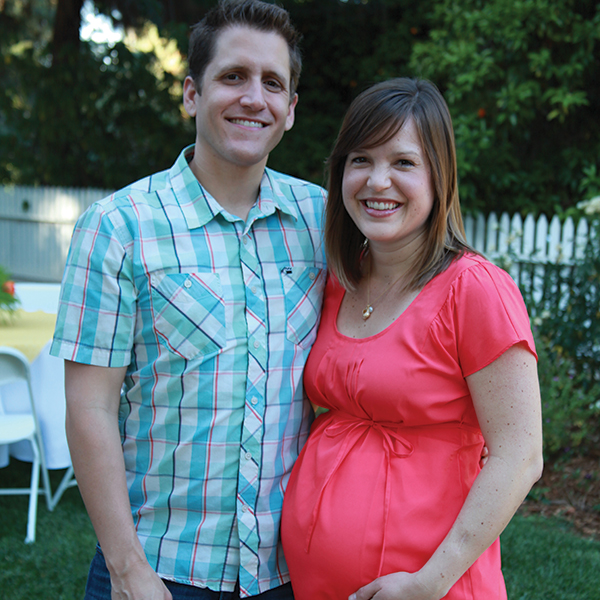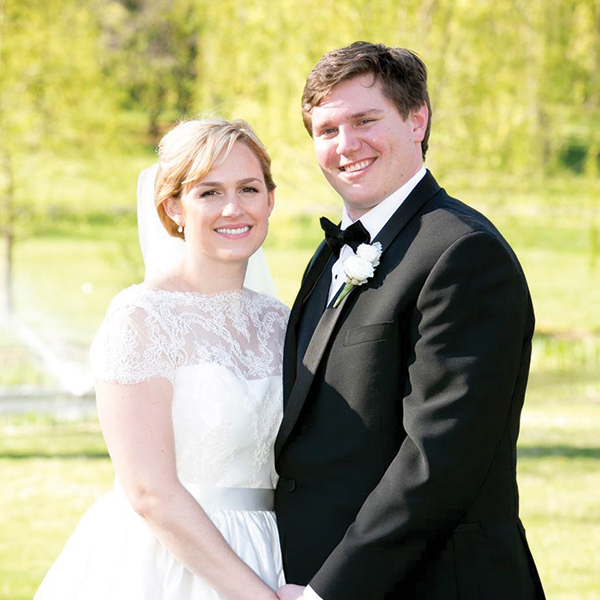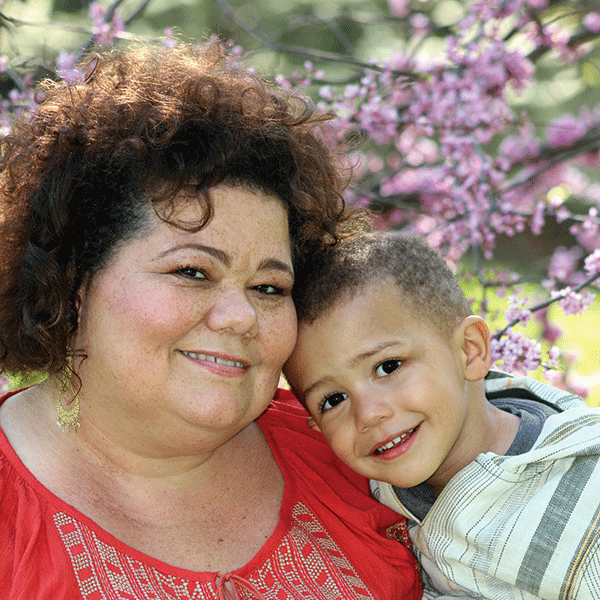AMID THE UNCERTAINTY of a cancer diagnosis, planning to have children may seem like checking your car’s gas gauge just before you brace for a crash. Still, men and women of childbearing age who are diagnosed with cancer often need to take a step back from making treatment decisions and find time to examine fertility preservation options that could help safeguard their hopes for a future family.
“There’s such a time crunch between the time you are diagnosed and when treatment starts. There is so much to learn and [you have] so many decisions to make,” says Juliana Fuller, a four-time cancer survivor who was diagnosed with stage I Ewing sarcoma in 2004, when she was 19. She was treated with chemotherapy and surgery. Seven years later, Fuller was diagnosed with cancer again, this time follicular lymphoma, at age 26. Within a week of being diagnosed, she met with a fertility specialist and started taking fertility drugs that stimulated her ovaries to make more eggs than normal. Once these eggs matured, they were extracted and joined with her husband’s sperm in a process called in vitro fertilization. The resulting embryos were frozen for later transfer to her uterus after cancer treatment.
“The decision to plan to have children [in the face of a cancer diagnosis] is multidimensional,” says Fuller, who has been disease-free since having surgeries for melanoma in situ in April 2013 and stage I basal cell carcinoma in August 2014. “I wanted to survive. I wanted the treatment I needed. But I always knew I wanted children,” she says. The Loma Linda, California, resident didn’t need to use her frozen embryos and was able to conceive naturally, but she felt reassured knowing she had done all she could to keep her options open. Fuller, now 30 years old, and her husband had their first child in June 2015.
Pregnancy does not appear to increase risk of death in breast cancer survivors.
In the past, pregnancy was not recommended for survivors with a history of breast cancer because of the resulting surge in hormones.
However, a published review of 14 smaller studies showed that women who got pregnant after having breast cancer had a 41 percent reduced risk of death compared with women with a history of breast cancer who did not get pregnant. Some researchers attribute this phenomenon to the “healthy mother effect,” noting that if a woman feels good, she may be more likely to become pregnant and live longer, whereas other women who haven’t recovered from treatment may not feel well and naturally do not become pregnant or live as long.
“We don’t know for sure why [pregnant women with a history of breast cancer have a reduced risk of death],” says Lisa Kolp, a reproductive endocrinologist at Johns Hopkins Fertility Center in Baltimore. “But it’s clear you are certainly not hurting your chance of survival if you get pregnant.”

Juliana Fuller and her husband, Corey, chose to do embryo cryopreservation after learning she was diagnosed with follicular lymphoma. The couple was able to conceive naturally. Photo by Myra Peterson
Let’s Talk About It
About 147,500 people under the age of 44 will be diagnosed with cancer this year in the U.S. To help guide patients in their childbearing years through what can be overwhelming choices, the American Society of Clinical Oncology (ASCO) issued clinical practice guidelines in 2006, with updates in 2013, emphasizing that health care providers should talk to their patients, and the parents or guardians of minors, about the effects of cancer treatment on fertility. The guidelines also stress that providers should refer patients to reproductive specialists, who can assist them in choosing fertility preservation options.
Despite these efforts, surveys indicate that young adults with cancer do not always receive fertility counseling. One survey published in the Dec. 10, 2009, Journal of Clinical Oncology indicated that only 47 percent of 516 oncologists referred cancer patients of childbearing age to fertility preservation specialists. In another study published March 15, 2012, in Cancer, just 61 percent of 1,041 women who received cancer treatment that could affect their reproductive function remembered talking with their doctors about it. Those who did talk with fertility specialists and trained fertility counselors reported a better quality of life and less regret years after treatment.
“It’s not uncommon that young adults feel that fertility, or even sexuality, has not been addressed at all within their cancer care,” says Kristin Smith, a patient navigator at the Robert H. Lurie Comprehensive Cancer Center of Northwestern University in Chicago. Smith specializes in helping newly diagnosed cancer patients through fertility preservation decisions and attends meetings with patients and fertility specialists. She says patients who are not informed of fertility options often feel a lot of regret and anger because “no one thought to say, ‘This may mean that you can’t have your own children in the future.’ It’s frustrating for young adults to not have been given the full picture.”
The best time to have a discussion about fertility preservation is before chemotherapy, radiation or surgery that could damage delicate eggs or sperm, experts say. Many factors, including age, treatment and type of cancer can affect a person’s future ability to have children.

Ashley Goldman, an ovarian cancer survivor, and her husband, Jamie, recently got married and hope to have children. Photo by Peter Oberc Photography
Goldman, who lives in Greenwich, Connecticut, had surgery to remove her left fallopian tube and ovary, and then completed nine weeks of a chemotherapy protocol known as BEP (bleomycin, etoposide and cisplatin). Goldman hopes she and her husband, who were married in May, will be able to conceive naturally. “Even though I didn’t make a plan to do anything, I’m glad I went. Just having the conversation opened my eyes to different options,” she says. These discussions can also make people aware of alternatives, including surrogacy and adoption, if treatment makes it impossible for them to conceive on their own.
Some people, often already overwhelmed with decisions regarding their cancer treatment, may struggle to find time and energy to fit in an appointment with a fertility specialist. “A lot of people don’t even make it to the first step just because they have so much going on,” says Karine Chung, a reproductive endocrinologist at USC Fertility, a program of the University of Southern California Keck School of Medicine, in Los Angeles.
In this video, patient navigator Kristin Smith discusses fertility preservation options for cancer patients.
However, new approaches have allowed women to quickly undergo fertility preservation so they can start cancer treatment as soon as possible. In the past, women had to wait up to six weeks to time taking fertility medications with the beginning of their menstrual cycle. By contrast, random-start ovarian stimulation allows women to start taking fertility drugs at any time during their cycles—often as soon as the day of referral. The process allows women to complete egg or embryo cryopreservation in just 10 to 14 days, which, in a lot of cases, is how long it takes for oncologists to run appropriate tests to come up with a treatment plan, says Chung.
“With cancer patients, we don’t necessarily have time to wait, so we can basically start the process at any time during their menstrual cycle,” says Chung, who notes that random-start ovarian stimulation became more common for cancer patients about five years ago. “Basically, the outcomes are very similar. You still get the same number of eggs and the same quality in terms of how the eggs fertilize.”
In the past, fertility preservation also wasn’t generally recommended for patients with hormone-sensitive breast cancer. Clinicians thought these patients’ exposure to fertility drugs that stimulate the body to make more eggs—as well as more estrogen—could also fuel cancer growth. However, several studies have shown that, in breast cancer patients, the risk of recurrence is no higher in women who undergo ovarian stimulation for fertility preservation than in those who do not.
Learn more about fertility preservation and alternative ways to start a family.
The following organizations can help you explore fertility preservation and alternative ways to start a family:
The American Cancer Society features information about fertility for men and women with cancer.
Inspire offers online patient communities, including support groups for specific types of cancer and for people dealing with infertility.
Imerman Angels pairs cancer patients, survivors and caregivers with mentors, including young cancer survivors who have had experience with and concerns about infertility.
The Livestrong Foundation offers a risk calculator to help assess how common cancer types and treatments can affect fertility.
The Lymphoma Research Foundation offers a national, one-to-one peer support program that matches lymphoma patients or caregivers with volunteers who have had similar lymphoma-related experiences. (Lymphoma is the most common cancer diagnosed in young adults between ages 15 and 24.)
The National Comprehensive Cancer Network created an online flipbook, Caring for Adolescents and Young Adults, that explores options for fertility preservation.
The Oncofertility Consortium at Northwestern University provides a list of adoption agencies that are willing to work with couples with a cancer history.
“[With fertility treatments,] we are giving hormone injections for a short period of time,” says Chung, adding that fertility preservation has been accepted as a safe option for breast cancer patients for more than 10 years. “Estrogen levels probably go above normal for five to 10 days, but we think such a short duration of exposure even to high estrogen levels is safe.”
To help keep estrogen levels in check for breast cancer patients who want their eggs harvested or their embryos preserved, reproductive endocrinologists can add one of two drugs commonly used to treat breast cancer to standard fertility drugs, Chung says. Tamoxifen, which was first used as a fertility drug in the 1970s to stimulate ovulation, blocks the effects of estrogen on breast tissue during ovarian stimulation. Another drug, Femara (letrozole), which is also used to treat breast cancer, interferes with the body’s ability to make estrogen, therefore keeping estrogen levels down while patients are taking drugs to promote egg production. “Both of these medications are believed to improve the safety of ovarian stimulation in breast cancer patients,” she says.
Some options may also help to preserve ovarian function during cancer treatment, including ovarian shielding during radiation, fertility-sparing surgical procedures (for certain women with ovarian cancer), and an experimental approach that uses drugs to shut down the ovaries during chemotherapy. The last approach was highlighted in a study published in the March 5, 2015, New England Journal of Medicine and showed that an ovarian suppression drug called Zoladex (goserelin), when administered before and during chemotherapy, helped to preserve ovarian function in premenopausal women with hormone-receptor negative breast cancer.
Several organizations will work with cancer patients to help with the cost of fertility preservation.
Fertility preservation options, such as in vitro fertilization procedures that allow patients to have their eggs fertilized and frozen for later transplantation into the uterus, can cost $12,000 to $20,000 per cycle, which can be an obstacle for cancer patients who are already worried about the financial strain of cancer treatment.
If these services aren’t covered by health insurance, says Kristin Smith, a patient navigator at the Robert H. Lurie Comprehensive Cancer Center of Northwestern University in Chicago, patients should still have their health care providers bill insurance and submit a letter of medical necessity. If the claim is denied, Smith recommends writing an appeal letter to the health insurance company. (See the following template of a letter.)
“We’ve had some really amazing and wonderful responses from insurance companies that tell us they will cover this, but the process can take time,” says Smith, who lives in one of 15 states in the U.S. that require insurance companies to cover some costs for reproductive assistance for people who are dealing with infertility.
Unfortunately, many insurance companies don’t consider cancer patients to be infertile before they start treatment. That’s because their fertility is generally intact then, but many fertility clinics do offer discounts to cancer patients to pursue fertility preservation. Smith recommends checking with local fertility specialists to see if one will see you quickly and be flexible on pricing.
The Livestrong Foundation has agreements with more than 400 fertility clinics in the U.S. that promise to provide at least a 25 percent discount, and often more, for the cost of fertility treatment. Livestrong also offers donated fertility drugs, which can save the patient up to $5,000, says Natalia Rojas Cerf, the foundation’s fertility services coordinator.
New Treatments, New Hurdles
Patients who are undergoing long-term drug regimens that help control cancer or reduce the risk of recurrence face an additional challenge. They have to weigh the risks of coming off the medications against their desire to start trying for a family. For example, Gleevec (imatinib), a drug that has helped to make chronic myeloid leukemia a manageable condition instead of a terminal one for many patients, may cause birth defects in developing fetuses. Thus, women who take Gleevec are counseled to use contraception to avoid pregnancy.
In May 2014, ASCO recommended that premenopausal women with early-stage hormone-sensitive breast cancer take tamoxifen for 10 years instead of five. The use of this drug as an adjuvant therapy, which means it’s administered after the primary cancer treatment, significantly lowers rates of recurrence and death. Women can still get pregnant while they are taking tamoxifen, but they are directed to take measures to avoid pregnancy because tamoxifen could damage a developing fetus. In addition, recent research indicates that a subset of women can reduce their risk of recurrence even further by pairing adjuvant tamoxifen with drugs that suppress ovarian function, which could further impede efforts to start a family.
“There is no data to inform the optimal time to have a baby, but the historical recommendation that women complete five years of tamoxifen before trying for a baby was never based on evidence,” says Dizon, adding that most oncologists are comfortable with patients taking a break after two years of using tamoxifen as a maintenance treatment if they want to start a family. “Practically speaking, the goals of the woman need to be considered when discussing breast cancer treatment and family planning.”

Laurie Trotman, a breast cancer survivor who underwent egg cryopreservation prior to cancer treatment, embraces her 3-year-old son, Tristan. Photo by Dominique Moore
Laurie Trotman faced this dilemma in 2008 when, at age 40, she was diagnosed with stage IIB breast cancer. Before starting her treatment, Trotman learned that even if her cancer went into remission, she would need to take tamoxifen for five years, which was the standard treatment recommendation at the time she was diagnosed, to reduce her chance of cancer recurrence.
“I just broke down, because what are the chances that you’ll have a baby at 46,” Trotman says. “It just hit me. Not only did I get cancer, but I had hoped to have a baby one day, and I knew then that I probably couldn’t.”
Trotman, who lived in New York City at the time, consulted a fertility specialist and decided to have her eggs frozen and stored. She underwent a lumpectomy and completed chemotherapy and radiation in March 2009. Despite hesitation and some fear about her cancer recurring, she moved forward with plans to become a single mom.
“It was like a light went on,” Trotman says. “It was like making a choice and not letting fear paralyze you, but allowing hope to push you.” In October 2010, Trotman decided to take a break from tamoxifen to try in vitro fertilization with donor sperm. After one failed attempt, she became pregnant with twins in July 2011. Though she lost one baby early in her pregnancy, she gave birth to her son, Tristan, on April 5, 2012.
New Livestrong program provides financial support for in vitro fertilization for female partners of male cancer survivors.
Sperm banking might seem like an obvious and easy choice for men who are facing cancer treatment that could affect fertility. Men can produce a sperm sample for storage at a sperm bank for just under $1,000, according to Natalia Rojas Cerf, the fertility services coordinator at the Livestrong Foundation.
However, when a couple is ready for parenthood after cancer treatment is over, fertility treatment can cost up to $20,000 per cycle. Until recently, male cancer survivors whose partners or wives were undergoing in vitro fertilization didn’t have access to the same financial assistance as female cancer survivors. But the Livestrong Foundation now offers a program open to 60 female partners of male cancer survivors so the women can receive the same free medications and discounts for doctors’ visits as female cancer survivors, Rojas Cerf says.
Trotman still remembers the day the reproductive endocrinologist harvested her eggs after her lumpectomy but before she started chemotherapy and radiation. Before the procedure, the anesthesiologist said to her, “We’ll save your eggs for a better time.”
“I couldn’t really see it then,” she recalls. “But doing [fertility preservation] really meant I was committed to there being a better time, and that made a big difference. Getting through treatment was hard, but this was my one ray of hope. And you should meet my son. He’s so happy. It’s like he just couldn’t wait to get here.”
Cancer Today magazine is free to cancer patients, survivors and caregivers who live in the U.S. Subscribe here to receive four issues per year.





